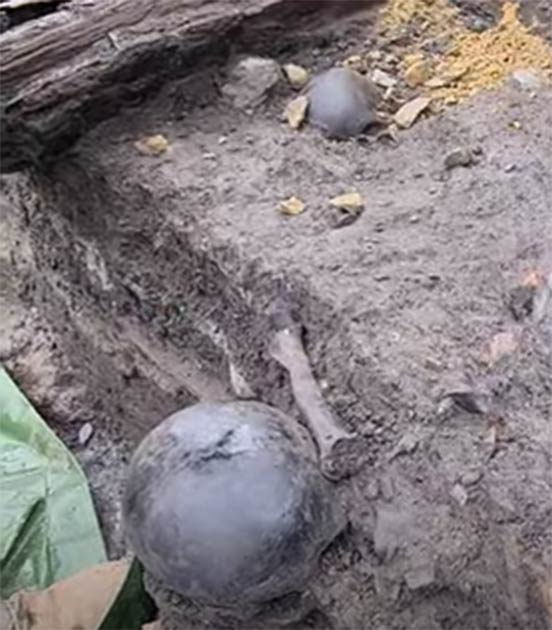
Unearthing The Baby Burning Witches Of Bochnia, Poland
Archaeologists in Poland have unearthed two witches’ skeletons that belonged to an unholy dark trinity, who in 1679 AD were burned at the stake. What did these three women, now known as the witches of Bochnia, do to deserve this fate? Well, according to church records, the witches of Bochnia stripped a baby of its veins, drunk them in a magical brew, and then burned the infant’s body.
The Witches Of Bochnia: Just Three Of Thousands Executed
Most noted for its 13th century World Heritage salt mine, the oldest functioning salt mine in Europe, Bochnia is a Polish town on the Raba River about 38 kilometers from the regional capital, Kraków. During recent excavations beneath the town’s medieval market archaeologists unearthed the burned remains of “two women,” who after being accused of witchcraft and murdering a child in 1679, were burned alive.

The Collegiate Basilica of St. Nicholas, dating from the 13th century, in the town of Bochnia, Poland, where the witches of Bochnia were discovered and burned at the stake. (Senatorek / Adobe Stock)
The witch trials took a while to get warmed up in Poland and the Church didn’t start burning people at the stake until the second half of the 17th century. However, the bishops made up for this slack start and extended the trials in Poland longer than elsewhere in Europe.
- Victims of Arrogance and Cruelty: The Pendle Witch Trials of 1612
- Why Did the Spanish Inquisition Allow Some Witches to Stay Alive?
- A Patriarchal Portrait of a Witch: Warning of Witchcraft in the Female Wiles
It was in 1776, the same year that USA was founded, that witch trials were banned in Poland, but this law wasn’t effectively enforced for another 50 years. It is estimated that between 3,000 and 4,000 people were executed for practicing sorcery in Poland.

A medieval witch dummy at the stake. (isaac74 / Adobe Stock)
Poland’s Witch Hunters Find Two Of The Witches Of Bochnia
Researcher Anetta Stachoń, from the Stanisław Fischer Museum in Bochnia, told local media that historical records detail a brutal execution that occurred in Bochnia in 1679 AD. The three women were burned alive after being accused of heinous acts of witchcraft and archaeologists have now found two of their charred skeletons.
Lead archaeologist Marcin Paternoga said the witches’ remains will be fully analyzed to determine exactly how they met their fates. However, “there are clues that they were indeed burned at the stake as their bones revealed burn marks from extreme temperatures.” A picture and a video of the remains can be seen here.

One of the skulls that was found at the site, blackened, presumably from the burning. (Bochnianin / You Tube)
One question that might be swimming around in your heads is “how,” after almost 400 years, could the skeletons of two burned witches still be found where they were executed? Dr Paternoga points out that folk found guilty of being witches “wouldn’t have been allowed to be buried on blessed grounds” and they were often buried where they died.
According to a report in The Express, based on the research of Anetta Stachoń, the three women who were burned alive were “Regina Wierzbicka from Prandocin, Maryna Mazurkowa of Bochnia, and Borucina of Niedar.” A report from 1995 says when Regina Wierzbicka was tortured, “she ended up admitting that she bought a newborn baby in order to fake her pregnancy so that the man she loved would marry her.” Then, Borucina forced Wierzbicka ’s lover to murder the baby and they, wait for it, “used the child ’s veins in an enchanted decoction.”

The two sets of remains were found in close proximity.
Accused, Charged And Burned, All In One Afternoon
Wierzbicka and Mazurkowa ultimately admitted to “casting spells, flying, and meeting with the devil,” but the two women claimed Borucina had taught them these diabolical arts. However, the worst was yet to come.
When the three mistresses of Satan were asked where the child ’s body was disposed of, they confessed to having “burned it to dust and then, on Borucina ’s order, she and Wierzbicka had to drink a decoction from it.”
According to an article about the discovery in Bochnianin the researchers believe that soon after their confession the three women were quickly lashed to a pole and hastily burned alive over a pit, “which at that time symbolized that they were descending into Hell to pay for their awful sins.”
This event occurred towards the end of the trials in Poland and the first known witchcraft case was when Bishop Jakub von Płock (1396–1425 AD) charged Damian of Borków of heresy, but this charge was dropped from a lack of evidence.
In 1476 AD, Dorota of Zakrzew, was destined to be burned for sorcery in Poznań but the verdict was repealed.
Thus, the first confirmed execution for witchcraft in Poland took place in 1511 AD when an unknown woman was executed in Waliszew.
The archaeologists excavating in Bochnia are convinced that if they continue digging they will find the skeleton of the third witch, which will complete this unfolding story of the “baby burning witches of Bochnia.”
Top image: A witch burning at the stake, just like the three witches of Bochnia were executed for their heinous crimes. Source: Matrioshka / Adobe Stock
By Ashley Cowie
















Comments
I wish once the 3rd ‘witch’ bones are found that representative of the Catholic Church would come to Bless these womens bones & their souls & proclaim to the world what an injustice was done to them in the name of God & Jesus.